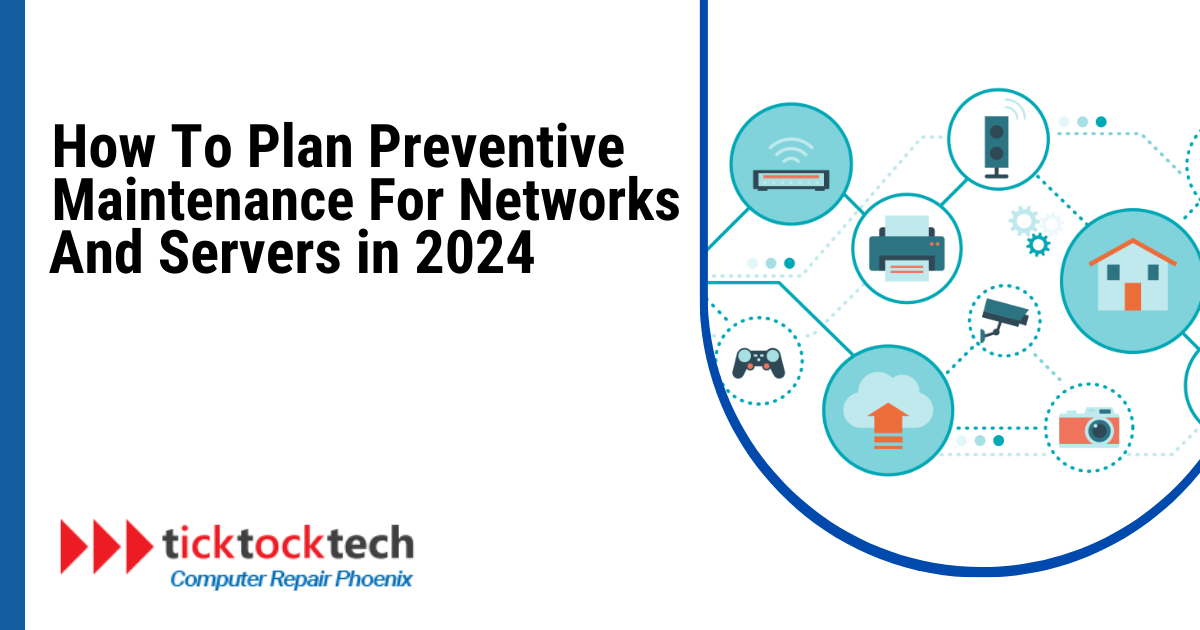Computers and laptops are not the only IT infrastructures that need maintenance. This also applies to all IT gadgets including the networks, servers, and other gadgets aiding the business, or connected to the computer. Networks and servers are used for Communication and Collaboration, File Sharing and Storage, and Resource Sharing. Also, for Data management, Business applications, and internet access mostly. Even if you maintain your computers regularly, making your network devices vulnerable will also affect your computer devices. Network and server maintenance is not to be done when there is a problem, they are done to prevent problems.
This implies that they should be properly planned. Networks and servers receive, store, and transmit a lot of data, and these are crucial parts of IT infrastructures.
Vulnerability in networks and servers could lead to complete loss of data or data getting stolen. They could get attacked by cyber-attacks which can cause damage, especially for companies or businesses. However, how do you plan to prevent these by maintenance? Here’s a complete guide to it.
1. Network and Server Connections Assessment
Checking your network and server connections thoroughly daily should be your first maintenance step. This procedure includes analyzing the current infrastructure, assessing connection speeds, and looking for potential bottlenecks. By examining network traffic, you can spot places that are congested and improve data flow. Evaluating server connections makes certain that every device is communicating with each other efficiently, reducing latency and enhancing performance in general.
Related: How to connect to a server
Network assessments consist of
i Network mapping: Create a thorough network map that shows the locations of all connected devices, including firewalls, switches, routers, and servers.
ii Network performance monitoring: Make use of technologies to keep an eye on latency, packet loss, and bandwidth consumption.
iv Network vulnerability assessment: Check your network for weaknesses and risks to its security.
iv Server configuration review: Verify that server configurations are properly set up and configured by looking over them.
This proactive approach creates the framework for scalable and effective network operations in addition to averting potential disruptions.
2. Hardware Maintenance and Troubleshooting
The long-term survival of servers and networks depends on routine hardware maintenance. Establish a regular check plan that covers switches, routers, servers, and other crucial parts. This process includes checking for wear, replacing outdated hardware, and updating software. System failures and downtime are minimized when hardware defects are troubleshooted as soon as possible. A stable environment for company operations is made possible by a well-maintained hardware infrastructure, which increases server and network resilience.
Related: Setting up and configuring wireless security
Upgrading and cleaning hardware: Make sure your hardware is cleaned frequently to prevent overheating and provide optimal airflow. Upgrade hardware components as necessary to keep performance at its best.
ii Hardware troubleshooting: Fix hardware issues as quickly as you can to prevent them from getting worse.
iii Replacing worn-out parts: Replace worn-out parts before they fail to guarantee continuing optimal functioning.
3. Disaster Recovery Plans
As part of preventive maintenance, creating strong strategies for disaster recovery is essential. Describe exact recovery procedures to be ready for unforeseen events like system failures, hacker attacks, or natural disasters. Redundant data and emergency accessibility are guaranteed by implementing cloud-based solutions and off-site backups.
As technology develops, these tactics should be regularly tested to guarantee their efficacy. In the case of an unforeseen incident, a well-thought-out disaster recovery plan can help businesses quickly resume operations by reducing downtime and safeguarding critical data. The process for this includes:
i) Data backup: Make frequent backups of your important data to a secure location.
ii) System imaging: Make system pictures of the workstations and servers that are most important to you.
iii) Disaster recovery procedures: Establish ways to recover your servers and network in the event of an emergency.
iv) Testing and Validation: To make sure your disaster recovery plans are working, test and validate them frequently.
4. Data Backup and Recovery
As soon as possible, install a complete data backup and recovery solution. Regularly backup important data to safe havens, encrypting it for added security. Automated backup schedules guarantee consistency and lower the risk of human error. Having a strong recovery plan in place ensures prompt restoration in the event of data loss. To store data in a secure and scalable manner, think about cloud-based options. Taking a comprehensive strategy for data backup and recovery not only protects against possible intrusions but also fosters stakeholder confidence regarding the security of sensitive data.
See Also: Data backup and recovery strategies you should know in 2024
i) Backing up important data: Ensure that your important data is regularly backed up to a secure location.
ii) Data redundancy: Put data redundancy into practice to make sure that your data is accessible if one or more systems malfunction.
iii) Data recovery procedures: Establish procedures for getting your data back in case of an emergency or loss.

5. Virus and Malware Prevention Plans
Preventative maintenance for network and server should include a strategy to safeguard against viruses and malware. As part of this strategy, you should employ anti-virus and anti-malware software and conduct frequent scans of your servers and network for malware and viruses.
Related: Best antivirus and anti malware software in 2023
Keep an eye out for and eliminate any threats to servers and network systems regularly. Not only does preventative virus and malware protection safeguard sensitive data, but it also keeps business processes running smoothly.
Keeping your antivirus and anti-malware software up-to-date with the latest signatures and algorithms can maximize the efficacy of your strategy for preventing viruses and malware. Software updates, done on a weekly or monthly basis, will take care of this.
6. Automatic Network Software Updates
It is important to ensure that systems have the most up-to-date features and security fixes via automating network software upgrades. Updating network software regularly fixes security holes that cybercriminals may use. Automate the updating process using patch management tools to minimize the risk of missing critical updates. Automation of these upgrades allows businesses to enhance system efficiency, fix faults, and tighten security without the need for manual involvement.
You may arrange your network devices to automatically update their firmware or use a software update tool to achieve automatic upgrades. Regardless of the method you choose, ensuring that your updates are coming from reliable sources will greatly decrease the likelihood of downloading malware or viruses.
7. Security Audits and Updates
It’s critical to routinely inspect your network and servers for security vulnerabilities. Analyze existing security practices and guidelines as part of thorough evaluations done in cooperation with cybersecurity specialists. In light of the audit’s findings, update the processes to improve safety standards.
Security updates have the potential to modify protocols and guidelines in addition to addressing vulnerabilities. Installing security updates right away is necessary to defend your servers and network from the most recent attacks.
This proactive strategy aids firms in adjusting their security policies to the always-evolving cyber threats, allowing them to stay ahead of any attacks.
8. Test run Security Measures
Before implementing new security measures, make sure they are thoroughly tested to make sure they function as intended without interfering with existing activities. By mimicking prospective cyberattacks, evaluate the effectiveness of the security mechanisms in place.
Doing simulated assaults on your servers and network is one technique to determine whether your security measures are sufficient. This might make it simpler to identify security flaws and provide fixes. This enables companies to identify security gaps in their infrastructure and address them before hackers can exploit them.
9. Staff Education and Awareness
Make sure your employees understand their role in maintaining a secure network and the significance of cybersecurity. Educate your staff about the signs of phishing emails, how to make strong passwords, and how to report security issues.
Always remind your employees to use strong passwords, stay alert for phishing attempts, and know the consequences of downloading suspicious files throughout your cybersecurity best practices training sessions. In addition to technological protections, businesses may build a human firewall by promoting security awareness inside the company. The network’s overall resilience is enhanced when educated staff actively protect it against cyber threats.
10. Security Plans for Connected Devices
Make an IoT security plan and make sure all IoT devices are updated and configured appropriately. Keep an eye out for odd behavior from these devices and take the appropriate safety measures to minimize risks. Make a list of every device that is linked to the network, including printers and smart thermostats. Install stringent security precautions on every device, such as regular firmware updates and special login passwords.
To lower the danger of a hack, use network segmentation to keep critical business data apart from IoT devices. Every connected device becomes a safe asset rather than a threat with the help of a well-executed security policy, improving the overall health of the network.
Take Away
Finally, proactive network and server preventative maintenance planning in 2024 is critical for assuring the seamless running of IT systems. Given the importance of networks and servers in communication, collaboration, information sharing, and resource management, focusing on vulnerability prevention becomes critical. A complete approach is formed by initiatives such as network and server connection evaluation, hardware maintenance, disaster recovery planning, data backup and recovery, virus and malware protection, automated software upgrades, security audits, and staff education. Testing security measures and developing a security plan for connected devices help to strengthen the network’s resilience. Businesses may navigate the changing cyber landscape with confidence and protect their essential data by using these safeguards.
FAQs
A: Network security maintenance involves implementing proactive measures to ensure the integrity, confidentiality, and availability of data within a network. It includes regular updates, security audits, and staff training to mitigate potential risks.
A: The benefits include enhanced cybersecurity, improved system performance, minimized downtime, compliance with evolving regulations, and a proactive defense against emerging cyber threats.
A: The top procedures include regular software updates, security audits, and staff education to create a holistic preventive maintenance approach.

